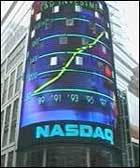How Stocks Trade
Most stocks are traded on exchanges, which are places where buyers and sellers meet and decide on a price. Some exchanges are physical locations where transactions are carried out on a trading floor. You've probably seen pictures of a trading floor, in which traders are wildly throwing their arms up, waving, yelling, and signalling to each other. The other type of exchange is virtual; composed of a network of computers where trades are made electronically.
The purpose of a stock market is to facilitate the exchange of securities between buyers and sellers, thus reducing the risks of investing. Just imagine how difficult it would be to sell shares if you had to call around the neighbourhood trying to find a buyer. Really, a stock market is nothing more than a super-sophisticated farmers market linking buyers and sellers.
Before we go on, we should distinguish between the "primary" market and the "secondary" market. The primary market is where securities are created (by means of an IPO) while, in the secondary market, investors trade previously-issued securities without the involvement of the issuing-companies. The secondary market is what people are referring to when they talk about "the stock market." It is important to understand that the trading of a company's stock does not directly involve that company.
The New York Stock Exchange
The most prestigious exchange in the world is the New York Stock Exchange (NYSE). The "Big Board" was founded over 200 years ago in 1792 with the signing of the Buttonwood Agreement by 24 New York City stockbrokers and merchants. Currently the NYSE, with stocks like General Electric, McDonald's, Citigroup, Coca-Cola, Gillette, and Wal-mart, is the market of choice for the largest companies in America.

The NYSE is the first type of exchange (as we referred to above), where much of the trading is done face-to-face on a trading floor. This is also referred to as a "listed" exchange. Orders come in through brokerage firms that are members of the exchange and flow down to floor brokers who go to a specific spot on the floor where the stock trades. At this location, known as the trading post, there is a specific person known as the "specialist" whose job is to match buyers and sellers. Prices are determined using an auction method: the current price is the highest amount any buyer is willing to pay and the lowest price at which someone is willing to sell. Once a trade has been made, the details are sent back to the brokerage firm, who then notifies the investor who placed the order. Although there is human contact in this process, don't think that the NYSE is still in the stone age; computers do play a huge role in the process.
The Nasdaq
The second type of exchange is the virtual sort called an over-the-counter (OTC) market, of which the Nasdaq is the most popular. These markets have no central location or floor brokers whatsoever. Trading is done through a computer and telecommunications network of dealers. It used to be that the largest companies were listed only on the NYSE while all other "second tier" stocks traded on the other exchanges. The tech boom of the late 90s changed all this; now the Nasdaq is home to several big technology companies such as Microsoft, Cisco, Intel, Dell, and Oracle. This has resulted in the Nasdaq becoming a serious competitor to the NYSE.


On the Nasdaq brokerages act as "market makers" for various stocks. A market maker provides continuous bid and ask prices within a prescribed percentage spread for shares for which they are designated to make a market. They may match up buyers and sellers directly but usually they will maintain an inventory of shares to meet demands of investors.
Other Exchanges
The third largest exchange in the U.S. is the American Stock Exchange (AMEX). The AMEX used to be an alternative to the NYSE, but that role has since been filled by the Nasdaq. In fact, the National Association of Securities Dealers (NASD) , which is the parent of Nasdaq, bought the AMEX in 1998. Almost all trading now on the AMEX is in small-cap stocks and derivatives .
There are many stock exchanges located in just about every country around the world. American markets are undoubtedly the largest and thus most important, but they still represent only a fraction of total investment around the globe. The two other main financial hubs are London, home of the London Stock Exchange, and Hong Kong, home of the Hong Kong Stock Exchange.
The last place worth mentioning is the over-the-counter bulletin board (OTCBB). The Nasdaq technically is an over-the-counter market, but the term commonly refers to small public companies that don't meet the listing requirements of any of the regulated markets, including the Nasdaq. The OTCBB is home to penny stocks because there is little to no regulation. This makes investing in an OTCBB stock very risky.
